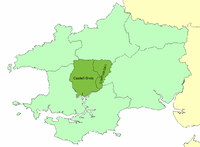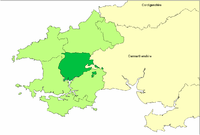
Dungleddy (hundred)
Encyclopedia


Pembrokeshire
Pembrokeshire is a county in the south west of Wales. It borders Carmarthenshire to the east and Ceredigion to the north east. The county town is Haverfordwest where Pembrokeshire County Council is headquartered....
, Wales
Wales
Wales is a country that is part of the United Kingdom and the island of Great Britain, bordered by England to its east and the Atlantic Ocean and Irish Sea to its west. It has a population of three million, and a total area of 20,779 km²...
, and was almost identical to the pre-Norman cantref of Deugleddyf. It derives its Welsh
Welsh language
Welsh is a member of the Brythonic branch of the Celtic languages spoken natively in Wales, by some along the Welsh border in England, and in Y Wladfa...
name from its position between the two branches of the River Cleddau
River Cleddau
The River Cleddau consists of the Eastern and Western Cleddau rivers in Pembrokeshire, west Wales. They unite to form the Daugleddau estuary, which forms the important harbour of Milford Haven....
(Cleddyf): the English form is a corruption of the Welsh. The area of the cantref was around 185 km2: it was the smallest of the seven cantrefi of Dyfed.
The cantref was allegedly divided into two commotes. The Red Book of Hergest
Red Book of Hergest
The Red Book of Hergest is a large vellum manuscript written shortly after 1382, which ranks as one of the most important medieval manuscripts written in the Welsh language. It preserves a collection of Welsh prose and poetry, notably the tales of the Mabinogion, Gogynfeirdd poetry...
calls these "Castell Hu" (= modern Cas-wis or Wiston) and "Llan y Hadein" (=Llanhuadain or Llawhaden). These both appear to be post-Norman lordships and are not genuine native subdivisions. The western part of the hundred was English-speaking from the time of the Norman conquest, and formed part of Little England beyond Wales
Little England beyond Wales
Little England beyond Wales is a name applied to an area of southern Pembrokeshire and southwestern Carmarthenshire in Wales, which has been English in language and culture for many centuries despite its remoteness from the English border...
: the eastern part was part of the Lordship of the Bishop of St David's
Bishop of St David's
The Bishop of St David's is the ordinary of the Church in Wales Diocese of St David's.The succession of bishops stretches back to Saint David who in the 6th century established his seat in what is today the city of St David's in Pembrokeshire, founding St David's Cathedral. The current Bishop of St...
, and George Owen described it as bilingual. The three northeastern parishes (Llys y Fran, New Moat and Bletherston
Bletherston
Bletherston is a hamlet and parish in Pembrokeshire, Wales. It is situated in the middle of the county, 9 km north of Narberth and 13 km east of Haverfordwest. The parish includes the village of Penffordd...
) were solidly Welsh-speaking during the 20th century.
As their names imply, the civil headquarters of the commotes were at Wiston
Wiston, Pembrokeshire
Wiston is a village and community in Pembrokeshire, Wales, in the United Kingdom. It was once a marcher borough. Owen, in 1603, described it as one of nine Pembrokeshire "boroughs in decay"...
and Llawhaden
Llawhaden
Llawhaden is a village and parish in the Hundred of Dungleddy , Pembrokeshire, West Wales.Llawhaden was a civil parish, area 1865 Ha....
, and the latter the cantref's ecclesiastical centre, perhaps the seat of a bishop during the Age of the Saints
The hundred was formed by the Act of Union
Laws in Wales Acts 1535-1542
The Laws in Wales Acts 1535 and 1542 were parliamentary measures by which the legal system of Wales was annexed to England and the norms of English administration introduced. The intention was to create a single state and a single legal jurisdiction; frequently referred to as England and Wales...
of 1536: a small part was transferred to the hundred of Dewisland
Dewisland (hundred)
thumb|250px|right|The cantref of Pebidiog in ancient DyfedThe Hundred of Dewisland was a hundred in the north west of Pembrokeshire, Wales...
, and various fragments of church land (Llandissilio, Llanfallteg, Llangan, Crinow, Henllan, Grondre and western Llawhaden) were acquired from Cantref Gwarthaf
Cantref Gwarthaf (Dyfed)
thumb|250 px|right|Location of the Cantref GwarthafCantref Gwarthaf was the largest of the seven cantrefi of Dyfed. It subsequently became part of Deheubarth in around 950. It consisted of the southeastern part of Dyfed containing most of the basin of the River Tâf.The name means "upper-most...
.

